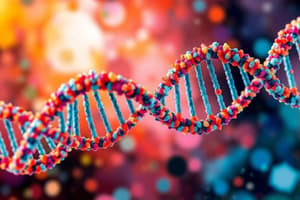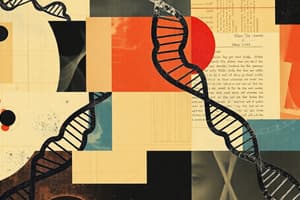Podcast
Questions and Answers
What were the primary gasses enveloping Earth during its transformation from a ball of gas and dust to liquid rock?
What were the primary gasses enveloping Earth during its transformation from a ball of gas and dust to liquid rock?
- Carbon dioxide, nitrogen, and sulfur (correct)
- Argon, hydrogen, and ozone
- Helium, oxygen, and nitrogen
- Oxygen, methane, and helium
What event is known for causing a drastic change in the chemical composition of Earth's atmosphere?
What event is known for causing a drastic change in the chemical composition of Earth's atmosphere?
- Primitive Cyanobacteria Evolution Event
- Great Oxygenation Event (correct)
- Tectonic Plate Movement Event
- Rodinia Formation Event
During which eon did the Earth cool down to form its crust?
During which eon did the Earth cool down to form its crust?
- Hadean Eon (correct)
- Archean Eon
- Proterozoic Eon
- Phanerozoic Eon
Which era was greatly impacted by the movement of tectonic plates forming the supercontinent Rodinia?
Which era was greatly impacted by the movement of tectonic plates forming the supercontinent Rodinia?
What caused the Earth to become more conducive to life and allowed single-celled cyanobacteria to exist?
What caused the Earth to become more conducive to life and allowed single-celled cyanobacteria to exist?
What caused a higher concentration of oxygen that led to the killing of many species of bacteria and protists?
What caused a higher concentration of oxygen that led to the killing of many species of bacteria and protists?
What is the primary purpose of recombinant DNA technology?
What is the primary purpose of recombinant DNA technology?
What is the role of ligation in the process of creating recombinant DNA?
What is the role of ligation in the process of creating recombinant DNA?
Which technique is used to insert the recombinant DNA into the host cell?
Which technique is used to insert the recombinant DNA into the host cell?
What is the purpose of using antibiotic resistance genes in the recombinant DNA process?
What is the purpose of using antibiotic resistance genes in the recombinant DNA process?
What is the purpose of sequencing the gene in the recombinant DNA process?
What is the purpose of sequencing the gene in the recombinant DNA process?
Which technique is used to distinguish DNA fragments of different lengths?
Which technique is used to distinguish DNA fragments of different lengths?
What is the primary purpose of DNA cloning?
What is the primary purpose of DNA cloning?
Which of the following is NOT a component used in the formation of recombinant DNA?
Which of the following is NOT a component used in the formation of recombinant DNA?
What is the role of a plasmid in DNA cloning?
What is the role of a plasmid in DNA cloning?
What is the function of a restriction enzyme in the formation of recombinant DNA?
What is the function of a restriction enzyme in the formation of recombinant DNA?
What is the purpose of transferring the recombinant plasmid into a host cell?
What is the purpose of transferring the recombinant plasmid into a host cell?
What is the difference between a plasmid and a recombinant plasmid?
What is the difference between a plasmid and a recombinant plasmid?
What is the purpose of choosing an appropriate vector in genetic engineering?
What is the purpose of choosing an appropriate vector in genetic engineering?
What is the role of restriction enzymes in genetic engineering?
What is the role of restriction enzymes in genetic engineering?
What is meant by a vector in the context of genetic engineering?
What is meant by a vector in the context of genetic engineering?
How does the bacterium assist in the production of identical cells with the recombinant plasmid?
How does the bacterium assist in the production of identical cells with the recombinant plasmid?
What is the function of a restriction endonuclease (REase) in genetic engineering?
What is the function of a restriction endonuclease (REase) in genetic engineering?
Why are complementary sticky ends left on either side of the DNA fragment after cutting by restriction enzymes?
Why are complementary sticky ends left on either side of the DNA fragment after cutting by restriction enzymes?
What is the significance of Proterozoic Rocks in relation to the evolution of life?
What is the significance of Proterozoic Rocks in relation to the evolution of life?
What distinguishes the Ediacaran Period from previous beliefs about early life forms?
What distinguishes the Ediacaran Period from previous beliefs about early life forms?
In relation to early chordates, what is significant about Pikaia gracilens?
In relation to early chordates, what is significant about Pikaia gracilens?
What do researchers suggest about a 1 billion-year-old fossil found in the Canadian Arctic?
What do researchers suggest about a 1 billion-year-old fossil found in the Canadian Arctic?
What sets Coronacollina acula apart from other organisms of its time?
What sets Coronacollina acula apart from other organisms of its time?
Why is Arandaspis notable in the context of early fish evolution?
Why is Arandaspis notable in the context of early fish evolution?
Flashcards are hidden until you start studying
Study Notes
Genetic Engineering and Recombinant DNA Technology
- Genetic engineering involves isolating a desired gene, inserting it into a vector, and transferring it to a host cell.
- The goal is to confer a desired trait to the host organism.
- Examples include inserting genes for pest resistance into plants or producing proteins in bacteria.
Steps in Genetic Engineering
- Choose the desired gene of interest and isolate it.
- Cut the gene of interest using restriction enzymes, leaving complementary sticky ends.
- Select an appropriate vector (e.g., plasmid or virus) and cut it with the same restriction enzyme.
- Join the gene of interest to the vector using DNA ligase, creating a recombinant DNA molecule.
- Transfer the recombinant DNA molecule into a host cell.
- Select transformed cells that contain the desired trait.
- Sequence the gene to determine the primary structure of the protein.
Formation of Recombinant DNA
- Recombinant DNA is constructed by mixing DNA from two different sources.
- A bacterial plasmid is typically used as a vector.
- A restriction enzyme is used to cut the plasmid at specific sites.
- The gene of interest is isolated, and DNA ligase joins the sticky ends of the vector and the gene of interest.
Plasmids
- A plasmid is a small, circular DNA strand found in bacteria.
- Plasmids are used in laboratory manipulation of genes.
History of Life on Earth
- The Earth's age is divided into four eons: Hadean, Archean, Proterozoic, and Phanerozoic.
- The Hadean Eon (4.5-4.0 billion years ago) was characterized by a partially molten surface, volcanism, and asteroid impacts.
- The Archean Eon (4,000-2,500 million years ago) saw the emergence of single-celled cyanobacteria.
- The Proterozoic Eon (2.5 billion-542 million years ago) was marked by the "Great Oxygenation Event" and the production of oxygen by cyanobacteria.
Evolution of Life
- The production of oxygen led to the death of many species of bacteria and protists.
- New types of organisms evolved using biochemical adaptations to survive the presence of oxygen.
- The first multicellular organisms, aerobic eukaryotes, dominated.
- Fossil records show evidence of primitive life-forms, such as bacteria and blue-green algae, in Proterozoic rocks.
- The Ediacaran Period saw the emergence of more complex animal species.
- The oldest known fossil chordate is Pikaia gracilens.
Studying That Suits You
Use AI to generate personalized quizzes and flashcards to suit your learning preferences.




